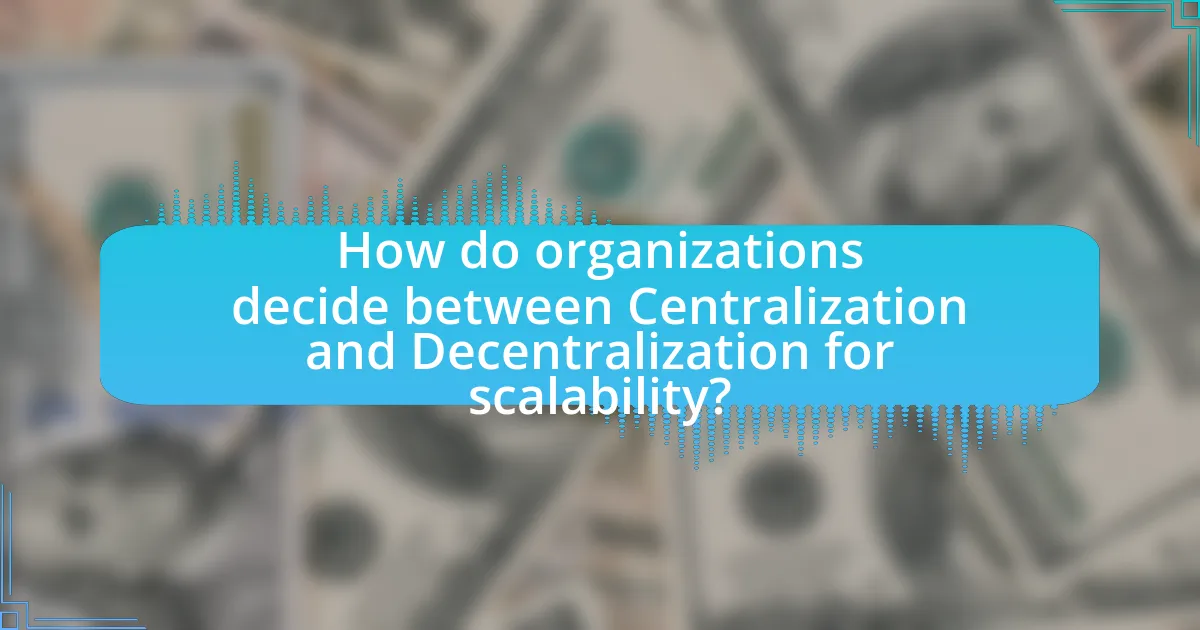The article analyzes the trade-offs between centralization and decentralization in scalability, focusing on how each approach impacts organizational efficiency and adaptability. Centralization consolidates control, allowing for streamlined decision-making and resource allocation, which can enhance performance but may lead to bottlenecks. In contrast, decentralization distributes authority across multiple entities, promoting resilience and innovation while potentially complicating coordination. Key characteristics, advantages, and challenges of both systems are examined, alongside factors influencing organizational decisions regarding scalability models, ultimately highlighting the importance of aligning scalability strategies with business goals.

What are the fundamental concepts of Centralization and Decentralization in Scalability?
Centralization in scalability refers to the concentration of control and decision-making authority within a single entity or a limited number of entities, which can lead to efficient resource allocation and streamlined processes. In contrast, decentralization distributes control across multiple entities, promoting resilience and flexibility but potentially resulting in inefficiencies and coordination challenges. The fundamental concepts highlight that centralization can enhance performance through unified governance, while decentralization fosters innovation and adaptability by leveraging diverse inputs and reducing single points of failure.
How do Centralization and Decentralization differ in terms of scalability?
Centralization and decentralization differ significantly in terms of scalability, with centralization typically offering easier scalability due to streamlined decision-making and resource allocation. In centralized systems, a single authority can quickly implement changes and scale operations, as seen in traditional corporate structures where resources are concentrated. Conversely, decentralization often faces challenges in scalability because it requires consensus among multiple independent entities, which can slow down decision-making and complicate resource distribution. For example, decentralized networks like blockchain require extensive coordination among nodes, which can hinder rapid scaling compared to centralized systems that can leverage existing infrastructure more efficiently.
What are the key characteristics of Centralized systems?
Centralized systems are characterized by a single point of control and decision-making authority. This structure allows for streamlined management and uniformity in operations, as all data and processes are managed from a central location. Additionally, centralized systems typically exhibit enhanced security, as data is stored in one place, reducing the risk of data breaches across multiple nodes. Furthermore, they often provide improved performance and efficiency due to reduced latency in communication and processing, as all components interact directly with the central server. These characteristics make centralized systems advantageous for organizations seeking consistency and control in their operations.
What are the key characteristics of Decentralized systems?
Decentralized systems are characterized by their distribution of control and decision-making across multiple nodes rather than a single central authority. This structure enhances resilience, as the failure of one node does not compromise the entire system, exemplified by blockchain technology where data is replicated across numerous participants. Additionally, decentralized systems promote transparency and trust, as transactions are recorded on a public ledger accessible to all users, reducing the risk of manipulation. Furthermore, they often exhibit improved scalability, as they can handle increased loads by adding more nodes, which contrasts with centralized systems that may face bottlenecks. These characteristics collectively contribute to the robustness and efficiency of decentralized systems in various applications.
Why is scalability important in system design?
Scalability is crucial in system design because it determines a system’s ability to handle increased loads without compromising performance. A scalable system can efficiently accommodate growth in users, transactions, or data volume, ensuring consistent service quality. For instance, according to a study by Amazon Web Services, systems that are designed with scalability in mind can reduce operational costs by up to 30% during peak usage times, demonstrating the economic benefits of scalability. Additionally, scalable systems can adapt to changing business needs, allowing organizations to remain competitive in dynamic markets.
What challenges do organizations face when scaling systems?
Organizations face several challenges when scaling systems, including technical limitations, resource allocation, and coordination complexities. Technical limitations arise from the need to upgrade infrastructure and software to handle increased loads, which can lead to performance bottlenecks. Resource allocation challenges occur as organizations must effectively distribute financial and human resources to support scaling efforts, often leading to budget constraints. Coordination complexities emerge when multiple teams or departments must collaborate, which can result in miscommunication and delays. These challenges are critical as they can hinder the overall scalability and efficiency of organizational systems.
How does scalability impact performance and user experience?
Scalability directly impacts performance and user experience by determining how well a system can handle increased loads without degradation. When a system is scalable, it can efficiently manage more users or transactions, leading to faster response times and improved reliability. For instance, a study by Amazon revealed that a 100-millisecond increase in load time can reduce sales by 1%. This demonstrates that effective scalability not only enhances performance but also significantly influences user satisfaction and retention.

What are the trade-offs between Centralization and Decentralization in Scalability?
Centralization offers streamlined decision-making and resource allocation, enhancing scalability through efficient management, while decentralization promotes resilience and flexibility, allowing for localized responses and innovation. Centralized systems can scale quickly due to unified control, but they risk bottlenecks and single points of failure. Conversely, decentralized systems can distribute load and reduce risks of failure, but they may face challenges in coordination and consistency across nodes. For instance, cloud service providers like Amazon Web Services (AWS) exemplify centralization with rapid scalability, while blockchain networks illustrate decentralization, enabling scalability through distributed consensus but often at the cost of speed and efficiency.
What are the advantages of Centralization in scalability?
Centralization in scalability offers advantages such as streamlined decision-making, improved resource allocation, and enhanced control over data management. Streamlined decision-making occurs because centralized systems reduce the number of stakeholders involved, allowing for quicker responses to changes in demand. Improved resource allocation is evident as centralized systems can efficiently distribute resources based on real-time data, optimizing performance and reducing waste. Enhanced control over data management ensures consistency and security, as centralized systems can implement uniform policies and protocols, minimizing the risk of data breaches. These advantages contribute to a more efficient and effective scalability strategy.
How does Centralization enhance control and management?
Centralization enhances control and management by consolidating decision-making authority within a single entity or leadership structure. This concentration allows for uniform policies and procedures, which can lead to increased efficiency and consistency across the organization. For instance, centralized organizations can implement standardized practices that reduce variability in operations, thereby improving overall performance. Additionally, centralization facilitates quicker decision-making as fewer individuals are involved in the approval process, allowing organizations to respond swiftly to changes in the market or operational challenges. Research indicates that centralized management structures can lead to higher levels of accountability, as it is clearer who is responsible for decisions and outcomes, thus enhancing oversight and governance.
What cost benefits does Centralization provide?
Centralization provides significant cost benefits by reducing operational expenses and improving resource allocation. By consolidating functions and decision-making processes, organizations can achieve economies of scale, leading to lower costs per unit of output. For instance, centralized purchasing can negotiate bulk discounts, resulting in substantial savings. Additionally, centralization minimizes redundancy in roles and systems, which streamlines operations and reduces overhead costs. According to a study by McKinsey & Company, companies that centralize their operations can reduce costs by up to 20% through improved efficiency and resource management.
What are the advantages of Decentralization in scalability?
Decentralization enhances scalability by distributing workloads across multiple nodes, which allows systems to handle increased demand more efficiently. This distribution reduces bottlenecks associated with centralized systems, where a single point of failure can hinder performance. For instance, in blockchain technology, decentralized networks can process transactions simultaneously across various nodes, leading to faster transaction times and improved throughput. Additionally, decentralized systems can scale horizontally, meaning that adding more nodes can increase capacity without significant redesign, as evidenced by the scalability of platforms like Ethereum, which can accommodate a growing number of users and applications.
How does Decentralization improve resilience and fault tolerance?
Decentralization improves resilience and fault tolerance by distributing control and resources across multiple nodes, reducing the risk of a single point of failure. In decentralized systems, if one node fails, others can continue to operate, ensuring that the overall system remains functional. For example, blockchain technology exemplifies this, as it allows transactions to be verified by numerous independent nodes, making it resistant to attacks or failures that could compromise a centralized system. Studies have shown that decentralized networks can maintain operational integrity even when a significant portion of nodes are compromised, demonstrating their superior fault tolerance compared to centralized architectures.
What flexibility does Decentralization offer to organizations?
Decentralization offers organizations the flexibility to make decisions at local levels, enabling quicker responses to market changes and customer needs. This structure allows individual units or teams to operate autonomously, fostering innovation and adaptability. For instance, companies like Unilever have successfully implemented decentralized decision-making, resulting in tailored products that resonate with local consumers, thereby enhancing market relevance and competitiveness.

How do organizations decide between Centralization and Decentralization for scalability?
Organizations decide between centralization and decentralization for scalability based on their strategic goals, operational efficiency, and the need for flexibility. Centralization allows for streamlined decision-making and uniformity, which can enhance efficiency in large-scale operations, as seen in companies like Walmart, where centralized control supports consistent supply chain management. Conversely, decentralization fosters agility and responsiveness to local markets, as demonstrated by multinational corporations like Unilever, which empowers regional managers to adapt strategies to local consumer preferences. Ultimately, the decision hinges on balancing the benefits of control and efficiency against the need for local responsiveness and innovation.
What factors influence the choice between Centralization and Decentralization?
The choice between centralization and decentralization is influenced by factors such as organizational size, complexity, control requirements, and decision-making speed. Larger organizations often lean towards decentralization to empower local managers and respond quickly to market changes, while smaller organizations may centralize to maintain tighter control and streamline decision-making processes. Additionally, the nature of the industry plays a crucial role; industries requiring rapid innovation may favor decentralization to foster creativity, whereas those needing strict compliance may opt for centralization to ensure uniformity. Historical examples, such as the shift of multinational corporations towards decentralized structures in the 1990s, illustrate how these factors can dictate organizational design.
How do organizational goals affect the decision-making process?
Organizational goals significantly influence the decision-making process by providing a clear framework for evaluating options and prioritizing actions. When goals are well-defined, they guide leaders and teams in assessing potential decisions against desired outcomes, ensuring alignment with the organization’s strategic direction. For instance, a study by Kaplan and Norton in “The Balanced Scorecard” highlights that organizations with clear objectives are more likely to make decisions that enhance performance and achieve long-term success. This alignment helps in resource allocation, risk assessment, and ultimately drives effective execution of strategies, reinforcing the importance of organizational goals in shaping decision-making.
What role does technology play in this decision?
Technology serves as a critical factor in the decision-making process regarding centralization versus decentralization in scalability. It influences the efficiency, speed, and effectiveness of operations, enabling organizations to choose a structure that best aligns with their scalability goals. For instance, cloud computing technologies facilitate decentralized systems by allowing data and applications to be accessed remotely, thus enhancing flexibility and responsiveness. Conversely, centralized systems can leverage advanced data analytics and machine learning technologies to streamline decision-making processes and optimize resource allocation. The impact of technology on this decision is evident in the growing reliance on digital tools that support either centralized or decentralized frameworks, ultimately shaping organizational strategies and operational capabilities.
What best practices should organizations follow when choosing a scalability model?
Organizations should prioritize alignment with business goals when choosing a scalability model. This involves assessing current and future needs, understanding workload patterns, and evaluating resource availability. For instance, a centralized model may be more efficient for organizations with uniform workloads, while a decentralized model can better accommodate diverse and fluctuating demands. Additionally, organizations should consider the cost implications of each model, as centralized systems may reduce overhead but can create bottlenecks, whereas decentralized systems may increase operational costs but enhance flexibility. Research indicates that 70% of organizations that align their scalability model with strategic objectives report improved performance outcomes.
How can organizations assess their specific needs for scalability?
Organizations can assess their specific needs for scalability by conducting a thorough analysis of their current operational capacity, projected growth, and resource allocation. This involves evaluating existing infrastructure, identifying bottlenecks, and forecasting future demands based on market trends and business objectives. For instance, a study by McKinsey & Company highlights that organizations that regularly analyze their scalability requirements can improve efficiency by up to 30%, demonstrating the importance of proactive assessment in adapting to growth.
What common pitfalls should organizations avoid in this decision-making process?
Organizations should avoid the pitfalls of over-centralization, lack of stakeholder involvement, and insufficient data analysis in the decision-making process regarding centralization versus decentralization. Over-centralization can lead to bottlenecks, stifling innovation and responsiveness, as seen in companies that have struggled to adapt to market changes due to rigid hierarchical structures. Lack of stakeholder involvement can result in decisions that do not reflect the needs and insights of those affected, leading to resistance and poor implementation. Insufficient data analysis can cause organizations to make uninformed choices, as evidenced by studies showing that data-driven decision-making significantly improves outcomes. By steering clear of these pitfalls, organizations can enhance their scalability and adaptability in a competitive landscape.

















